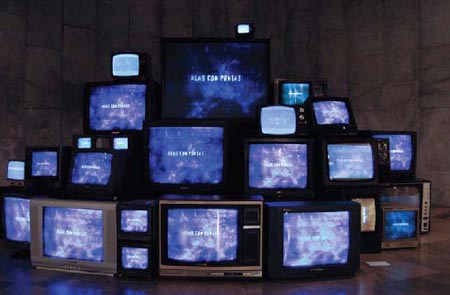Alas con puntas. A Work in Progress and its Main Ideoesthetic Codes
Tipped Wings is a project worth taking a look at for a number of good reasons. First of all, for its hefty multi– or interdisciplinary stamp in which the plastic arts, music, cinema and other expressions conjugate one another harmonically. Led by celebrated Cuban filmmaker Roberto Chile –and his equally valuable crew1), Tipped Wings has set out, from the word go back in 2008, to comprehensively exhibit and integrate some Cuban plastic artists’ proposals through their respective promotional videos, all of them directed by Chile. And the word promotional is typed in italics because is just because those abovementioned audiovisual materials are first of all boasting an openly artistic and bold vocation that is not solely related to passive showing or the common knowledge of a commercial product. Here, the video is not a mere documentation tool, not a simple advertising vehicle that was commissioned on demand, but rather an esthetic component in itself, self-governing, with ingrained values that occasionally verge on the video-art domains. These short-length materials are artistically up to par with their benchmarks as they foster dialogue and controversy –in the best sense of the word– into an enriching adding proposal.
But a limpid and honest admiration toward the target artists always oozes out of these works. All the elements of the audiovisual language –mounting, movements and camera angles, photography, soundtrack and more– are markedly semioticized, wrought with a view to recreate in a smart way –stripped of superficial linings or accents– the sensitivity, the stylistic work and the meaningful scope of the artworks contained in the films. Each video accurately integrates itself and partakes in the most intimate dramatic elements of their targets works. Each artistic shot is a complement that nourishes and enhances the sense of the pictorial piece, sculpture or installation. The two sides benefit from this exchange, both the director and the creators that gave him this inspiration. The soundtracks –most of them are original– were scored by Frank Fernandez, Alexis Bosch, Emilio Martini, Miguel Nuñez, Monica O’Reilly, Obsesión, Cristian Alejandro, Pancho Amat and Kelvis Ochoa. All of them make up beautiful and ingenious discursive articulations that sip the deepest contents directly from the poetics of the targeted artists.
Just another distinctive feature of Tipped Wings is its work-in-progress character that’s keen on multiple mutations, enhancements, revisions, turning points, both from a qualitative standpoint and in terms of the quantitative and geographical outlines. Under the premise of a genuine tribute to Jose Marti –explicit in the title and the fundamental expositive location of the project: the like-name memorial in the Revolution Square– the program has included nearly two dozen artists from different generations and esthetic affiliations: Roberto Fabelo, Jose M. Gomez Fresquet (Frémez), José Villa, Nelson Dominguez, Alexis Leyva Machado (Kcho), Alain Pino, Javier Guerra, William Perez, Eduardo Roca (Choco), Jose Fuster, Franklin Alvarez, Jose Antonio Hechavarria, Luis Enrique Camejo, Cirenaica Moreira, Jesus Lara, Reinerio Tamayo, Alicia Leal, Kamyl Bullaudy, Jorge Luis Santos and Dausell Valdes. Some are qualitatively better than others, but the list is prone to enhancements and enrichments. A good case in point is the latest presentation from the group, at the Osvaldo Guayasamin House & Museum in Old Havana, a well-deserved tribute to the outstanding Ecuadorian artist that included such boldface names as Agustin Bejarano, Enrique Baster, Vicente R. Bonachea, Francis Fernandez, Marlys Fuego, Ernesto Garcia Peña, Osvaldo Garcia, Veronica Guerra, Dagoberto Jaquinet, Lorenzo Linares, Kelvin Lopez, Mabel Poblet, Angel Ramirez, Ernesto Rancaño, Adrián Rumbaut…
From a spatial or territorial viewpoint, the project has no intention whatsoever to be exclusively limited to the island nation’s capital –a bad habit curators suffer from every so often– since it has tried to reach out to nearly all the provinces across the country and has likewise included conferences, students’ gatherings and debates where attendees talk about noble social and humane interests that go far beyond the esthetic universe.
As far as the plastic field is concerned, there are way too many artworks to be highlighted based on their consistency. These lines won’t be long enough to embrace them all. I can now recall nearly effortlessly that beautiful installation by Fabelo made up of casseroles, jars, coffeemakers, all of them rusty and old and laid out in the shape of our island nation’s silhouette. The island is growing older, hungrier, narrower, and so grow its hardships. And the people grow older too. Or it just stands its ground in its humble existence, in its gloomy presence. Also crossing my mind is the refined and concise abstract sculpture by Villa; that Che that marches on altruistically by Javier Guerra; the huge and seducing dices by Choco; Fuster’s good-looking lovers; the lavish and puzzling landscapes by Lara; Camejo’s automobiles that virtually come apart before our very eyes, with that bold, agitated paintbrush touch, generating an interesting essence/appearance and reality/fiction duality. Or just that suggestive femme that levitates in a Cirenaica picture as she just lets people watch part of her legs in an intriguing and disturbing way that flirts with the esthetics of death. And can be said of Franklin Alvarez’s gripping punching bags in which noble and innocent people are willing to be punched no less. It’s an incitation and provocation for the spectator, perhaps to prod him to become a sadist, to play the hangman game. It’s a possible allusion to the violence that marks our interpersonal, social and intersubjective relationships on a daily basis.
That just to name but a few examples, among many other that could be mentioned.
Let’s wait with our eyes wide open because new productions will be engrossing Tipped Wings, surely worth looking at as well. But let’s be certain that, like all human works, this is a perfectible project. There are still quite a number of skies to fly through.


























































